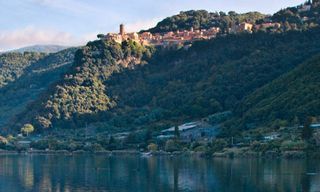This isn't Caligula's tomb

The news this morning is full of the "discovery" of the emperor Caligula's tomb at Nemi, by the lake about 30 kilometres out of Rome. The details are pretty murky. The police apparently arrested a guy who was loading a statue of the monster young emperor into the back of a lorry.
I havent seen a picture of this yet. But how do we know it was Caligula? Because, they say, it was wearing the 'caligae" or sandals that gave the emperor his nickname (his 'real' name was Gaius). Errr? Aren't there loads of Roman statues that wear these?
And why do we think that it marked his tomb?
Simple. Because it makes a good story that gets a load of press coverage for the discovery made by these no doubt brave policemen (the illicit antiquities business is probably second only to drug running in its nastiness).
All the evidence we have from the ancient world suggests that this cannot be so.
Caligula was assassinated in his palace on the Palatine Hill in Rome in 41 AD. According to Suetonius' Life (chap 59), his body was taken to the horti Lamiani, the site of an imperial pleasure gardens on the Esquiline Hill. There he was quickly cremated and buried a light covering of turf. Later on his sisters returned, to cremate and bury it properly.
There is no suggestion whatsoever, so far as I know, that this burial was at Nemi, or that it was a grand tomb (the Latin just says "buried", sepultum). True, Caligula had a big villa there, but it is almost inconceivable that this assassinated symbol of imperial monstrosity would have been given a grand monument, plus a big statue there.
Besides there is no evidence for that whatsoever.
Much more likely is that he had a modest burial in or near the horti Lamiani, or -- as some people think -- that he was slipped into the big Mausoleum of Augustus (where many of the imperial family ended up).
Mary Beard's Blog
- Mary Beard's profile
- 4115 followers



